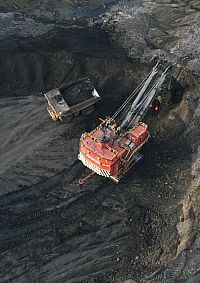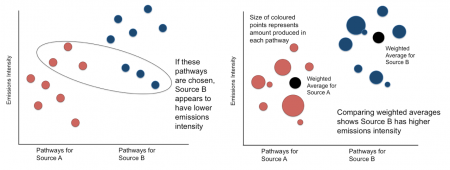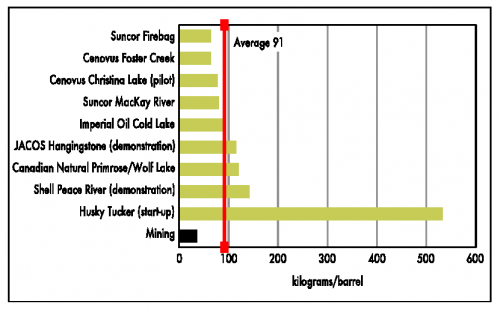Editor's Note: This blog post was updated on May 25, 2012 to reflect more detailed information about the pathways included in the Jacobs analysis. For more information, please contact [email:march].
Over the months ahead, expect to hear frequent references to a new report released Wednesday comparing the greenhouse gas emissions associated with oilsands production to those associated with other sources of crude oil used in Europe.
Initial media coverage presented the report as a new tool for those fighting criticism that oilsands fuel has a greater climate impact than conventional oil (because of the higher per-barrel emissions associated with producing and refining oilsands crude).
But we took a close read of the report, prepared for the Government of Alberta by Jacobs Consultancy, and there seems to be a problem: the report’s findings about how oilsands compare to conventional oil do not tell the full story, and government documents appear to misinterpret the implications of those findings.
Understanding emissions intensities
The emissions intensity of oilsands production has become a lightning rod for controversy since the European Union introduced a proposal to give preference to oil imports that have the lowest greenhouse-gas emissions values. The most rigorous analysis to date, commissioned by the European Union and completed in 2011 by Stanford University’s Adam Brandt, found that life-cycle emissions from oilsands production are 12 to 40 per cent higher than the average for conventional crude used in Europe, with the most likely or average oilsands barrel being 23 per cent more intensive.
Following the release of the Jacobs report, the Government of Alberta claimed this new research shows the EU’s designation of oilsands as higher-carbon than conventional oil is “flawed,” and said the proposed fuel-quality directive rules are based on “inaccurate” assumptions.
These conclusions, however, are not actually supported by the Jacobs report — suggesting it’s the government’s interpretation of the study that is flawed.
Government of Alberta claims not backed by data
Despite how it is being presented in the media, the Jacobs study was never designed to be a comprehensive assessment of oilsands emissions.
 The objective of the study was to compare how greenhouse gas emissions from crude oil production vary, depending on the source of the diesel or gasoline and methods of production used. The extraction processes and assumptions examined in the Jacobs report are not representative of what is typical in the oilsands. The report ignores many of the more emissions-intensive processes that make up a large part of current production — effectively cherry-picking examples of the cleanest oilsands projects.
The objective of the study was to compare how greenhouse gas emissions from crude oil production vary, depending on the source of the diesel or gasoline and methods of production used. The extraction processes and assumptions examined in the Jacobs report are not representative of what is typical in the oilsands. The report ignores many of the more emissions-intensive processes that make up a large part of current production — effectively cherry-picking examples of the cleanest oilsands projects.
A Government of Alberta review of the Jacobs report claims the study indicates the oilsands are similar (in terms of emissions intensity) to other crudes refined in the EU, stating:
“Specifically, Jacobs’ findings show that the average wells-to-wheels carbon intensity of gasoline and diesel from Alberta oil sands-derived crude oils are within 12 per cent of the carbon intensity of gasoline and diesel from crude oils refined in Europe and, in the case of some oil sands crude, within five per cent of EU crude oils.”
Contrast that with the following statement from the Jacobs report:
“For Alberta heavy crude oil produced via SAGD [steam assisted gravity drainage, a type of extraction used for in situ oilsands projects], the carbon intensity of diesel fuel is within 12 per cent of the upper range of carbon intensity for diesel from representative crude oils refined in Europe.” (emphasis added)
In other words, the Jacobs study says the emissions intensity of better-than-average oilsands falls within 12 per cent of the highest-carbon types of conventional crude refined in the EU. Yet the government’s documents appear to state that all oilsands have an emissions intensity just 12 per cent higher than all types of conventional crudes.
The Jacobs study does not characterize the full range of oilsands emissions, nor does it compare the average or most likely range for oilsands intensities. Instead, it examines a select group of high-performing oilsands projects, and makes optimistic assumptions about the potential for emissions reductions based on some technologies that are far from the norm in oilsands.
Even the Canadian Association of Petroleum Producers has acknowledged that the Jacobs report focused on “future technologies that are not widely used.” This assertion is not consistent with the government’s characterization of the Jacobs report as a comprehensive assessment of real-world oilsands greenhouse gas performance.
Given the limited scope of the Jacobs report, unfortunately it’s not possible to draw the kind of sweeping conclusions the government makes in its review of the study.
Rather, the Jacobs report shows that the very best (i.e. least emissions-intensive) examples of Alberta’s oilsands production are still almost entirely more emissions-intensive than other conventional oil production methods around the world.
In other words, the Jacobs study clearly reinforces the conclusion that the oilsands are a significantly more polluting feedstock than conventional crudes used in the EU, and should be treated as such.
Jacobs’ methodology tells an incomplete story
Understanding why the Jacobs report understates the emissions intensity of oilsands crudes requires looking at the methodology behind the report.
 Let’s start with a brief overview of the key terms used in the analysis. The “feedstock” refers to the type of crude (e.g. conventional crude, oilsands bitumen or coal-to-liquid). The “source” refers to the origin of the fuel: this term can be used broadly (to refer to the geographic region the crude comes from), in a project-specific sense (to identify whether the crude came from an oilsands mine or was extracted from an in situ project) or it can be used very precisely to identify the exact mine that produced the crude.
Let’s start with a brief overview of the key terms used in the analysis. The “feedstock” refers to the type of crude (e.g. conventional crude, oilsands bitumen or coal-to-liquid). The “source” refers to the origin of the fuel: this term can be used broadly (to refer to the geographic region the crude comes from), in a project-specific sense (to identify whether the crude came from an oilsands mine or was extracted from an in situ project) or it can be used very precisely to identify the exact mine that produced the crude.
The term “pathway” refers to the production process that the crude followed, from origin to market — and emissions intensities can vary significantly, depending on the pathway chosen. The geographic source matters less than the various steps the original crude has to go through to make it a refined product that can be sold on the market, as gasoline or diesel fuel. For instance, processing bitumen that is extracted from an in situ oilsands project will result in different amounts of greenhouse gas pollution depending on whether the crude is upgraded in Alberta or diluted and shipped to the U.S. to be upgraded and refined there.
Here’s the problem with the methodology used in the Jacobs analysis: even though it looks specifically at the various ways oilsands can be made, it doesn’t distinguish between which pathways are most typical today. It’s encouraging to see that there are some oilsands production methods that result in lower greenhouse gas emissions than others — but failing to account for the volume of oilsands crude that is produced along the various available pathways does not paint an accurate picture of the current emissions intensity of oilsands today, and distorts any comparison with emissions from conventional oil or other crude sources.
Figure 1, below, illustrates the difference between only considering the emissions intensities associated with various pathways (the uniform dots on the left), and considering the emissions intensities of various pathways relative to the amount of oil that is produced using each pathway (the dots of different sizes on the right). If you don’t consider how much oil is actually produced for each pathway, you can’t accurately compare between the real-world emissions associated with gasoline derived from oilsands crude and gasoline derived from conventional sources.
In other words, if a lot of oil is produced from high-emission pathways, and only a small amount is produced from lower-emission pathways, then the pathway doesn’t matter nearly as much as the overall average emissions for the oil produced.
A more accurate approach would be to look at a range of oilsands projects currently operating in Alberta and derive the average emissions value representative of production processes at those sites.
Figure 2, below, illustrates this approach using greenhouse gas emissions intensity data from the Pembina Institute’s evaluation of in situ oilsands projects. This figure only compares emissions from the production aspect of the fuel's life cycle, but it makes a clear point — there is a range of emissions associated with various oilsands projects in operation. (Like in situ, oilsands mining projects also have a range of emissions intensities.) Selecting just a few of these projects, particularly ones that perform better than average, and presenting them as characteristic of the industry’s performance as a whole would paint an inaccurate picture.
Report’s pathways focus on better-performing oilsands
In addition to using a methodology that risks underestimating industry-wide oilsands emissions, the pathways represented in the Jacobs report focus on the better-performing pathways and leave out some of those with higher emission intensities.
For example, the report represents pathways for thermal in situ oilsands where the extraction method is steam-assisted gravity drainage (SAGD). Cyclic steam stimulation (CSS) is another thermal in situ extraction method that typically produces more greenhouse gas emissions per barrel than SAGD. In Figure 2 for example, the four best-performing projects all use SAGD. CSS is not represented by the pathways compared in the Jacob's report, even though, as the report acknowledges, it does represent a significant portion of current production (32 per cent of in situ production). On the other hand, cold heavy oil production with sand (CHOPS) is another lower-emission pathway that is included in the study, even though it accounts for less production than CSS (less than 26 per cent of in situ production). (Note: SAGD accounts for 42 per cent of in situ oilsands production, all figures based on 2010 data).
The Jacob's report also leaves out a comparison of in situ oilsands pathways where the bitumen is upgraded in Alberta, rather than diluted and refined out of province by more efficient refineries that can effectively upgrade and refine at the same time. Again, diluted bitumen pathways typically have lower emissions than those that include upgrading as a separate step.
So in effect, the Jacob's report compares only a subset of the pathways that are typical in today's oilsands industry. As a result, the gap between the emissions intensity of the subset of oilsands pathways studied and the emissions intensity of other types of crude refined in Europe appears to be less significant than the EU’s characterization of oilsands emissions as 23 per cent higher on average than conventional.
Some good news for oilsands producers
The Jacobs report shows that some pathways can have lower emissions than the industry average — and this is good news for Alberta’s leading oilsands producers.
Ultimately, the goal behind the EU’s fuel-quality directive is to encourage reductions in greenhouse gas emissions. For the limited number of oilsands producers who are performing significantly better than the default emissions-intensity value, the EU policy allows these companies to report their own performance and get a customized emissions value.
Implications for Alberta and the EU
The Jacobs report is not a game changer for how oilsands are ranked in the proposed EU fuel-quality directive.
While the report does provide valuable information on a subset of oilsands pathways, this new research does not call into question the data on which the European Union is basing its emissions value for oilsands crude. Rather, the report shows that oilsands crudes are still, on average, higher-carbon sources than conventional oil. Therefore, the EU’s use of a ‘default’ value for bitumen (that can be replaced with values specific to high-performing oilsands projects) remains a fair approach.
The Government of Alberta could help oilsands producers remain competitive in carbon-constrained markets by setting provincial emissions-intensity reduction targets for oilsands operations that are consistent with the EU’s conventional oil value. This would encourage companies to more broadly deploy new technologies that reduce emissions intensities.








